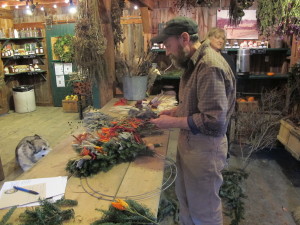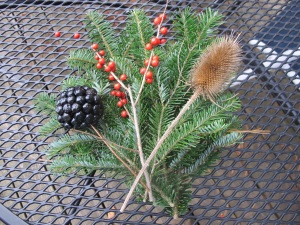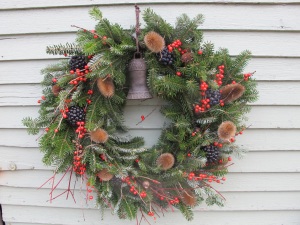Wreaths
Lights, decorated trees, carols on the radio and in the stores: all these say the holidays are here. For several years now I’ve been too busy (or too lazy) to create my own wreath, but this year I was inspired to make one. I saw some simply amazing wreaths made by Gary Hamel and Amy Franklin of Riverview Farm in Plainfield, NH (www.riverviewnh.com) and called Gary to see if I could come and watch them work. Later I made my own – and you can, too.
Gary is an artist and Jack-of-all trades. His mother, Alice, made a wreath for their front door every year using materials from their farm to celebrate the solstice and brighten the season. On a flyer for wreath workshops at Riverview Farm, Gary wrote that a wreath is ”the symbol of unending years. The evergreen boughs represent the continuing presence of life in winter’s deep sleep. The dried flowers are the memory of the season past, and the grasses and seeds are the presence of the year to come”. I like that.
The Franklins at Riverview Farm grow and collect materials for their wreaths all year. Prime among the ingredients are dried Thai peppers – some red, some yellow – which grow several to a stem. They hang them in the barn to dry and get ready for wreath season. Also available for use in wreaths are dried miniature ears of corn, stems of rye and decorative grasses, shallots, rose hips, dried flowers, cones, nuts and and dried leaves. As Gary said, “this is not your grandmother’s wreath.”
Gary explained that the four herbs of the advent season are rosemary, sage, lavender and thyme, so he likes to use them in wreaths, too. Fragrant herbs like those four and others such as Sweet Annie (a vigorous growing perennial in the Artemesia genus) smell great when making the wreaths, but probably aren’t noticeable to most people once they are on the front door.
Making a wreath is not tough work at all. First I went to a Christmas tree farm and got a “reject” – a balsam fir tree that would not normally be salable. I wasn’t sure how many branches I would need, so I lugged the whole tree home. It turns out that I only needed about five branches.
Balsam fir is probably the best tree for making wreaths, though Gary and Amy also mix in some cedar or pine in some of their wreaths. Spruce is also suitable, but a bit prickly to work with. Canadian hemlock is not suitable – the needles fall off too soon, even if kept cold.
I wanted some bright color for my wreath, so I put on my barn boots and headed off to a local swamp where I had seen the bright red berries of winterberry, our native deciduous holly (Ilex verticillata). Winterberry usually grows in standing water, and most years I get my feet wet, boots or not.
This year I got smarter: I brought my pole pruner. The one I use has a pistol grip like a pair of hand pruners which allows me not only snip off berry-laden branches, but also to grab the cut branches by squeezing gently on the handle. The one I use is made by ARS and sold by an orchard supply company in Massachusetts, OESCO (www.oescoinc.com).
Winterberry tends to drop its berries, but Gary Hamel told me how to prevent that: get a can of clear Rust-oleum paint and spray the branches. At the hardware store a helpful clerk suggested that of the various clear products, lacquer would work best as a glue, so that is what I used. When I made my wreath, only a few of the berries fell off.
I collected other dried plants for my wreath including goldenrod stems with galls, teasel (a weed with wonderful prickly seed pods), dried black-eyed Susan and bee balm stems, red-twigged dogwood and 2-inch spheres of blue-black berries of the wild vine, carrion berry (Smilax herbacea). I sprayed the carrion berries with the lacquer to keep them from falling off, too.
A key to a good wreath is making the stems secure. Buy a spool of green wreath wire from your local garden center or florist, and a wire wreath form. I used a double ring 18 inches in diameter. This year, instead of making bundles and then attaching them, I followed Gary’s technique of using one continuous piece of wire for the entire wreath, tying the bundles on as the wreath progressed.
First, I tied the wire securely onto the wreath form. Then I made and attached my greens and decorative elements. At the base of each bundle I made five tight loops of wire around the stems going one way, then another 3 or 4 turns going back the other. That made the greens very secure.
Each bundle I made started with 5 stems of balsam fir. Two were about 10 inches long, the other three were shorter. Then I placed a stem of winterberry in the middle, and added other elements. I alternated the various elements, some in one bundle, then skipping them in the next, repeating in the third. Only the red berries and fir were in each bundle. Each bundle should be about the size and shape of your hand.
It takes about 20 bundles of greens to complete a wreath. The only tricky part is at the very end, to attach the last bundle. I see why people use red ribbons at the top: not only to look good, but to cover up the inevitable gap. I didn’t have a ribbon, so I used a brass bell. Gary’s mom insisted that her wreath come off the door on February 2, Groundhog’s Day, also known as Candelmas. She unwound the wire and burned the greens. Me? I’ll keep it up as long as it looks good.
Henry is the author of 5 books. His website is www.Gardening-Guy.com/.





